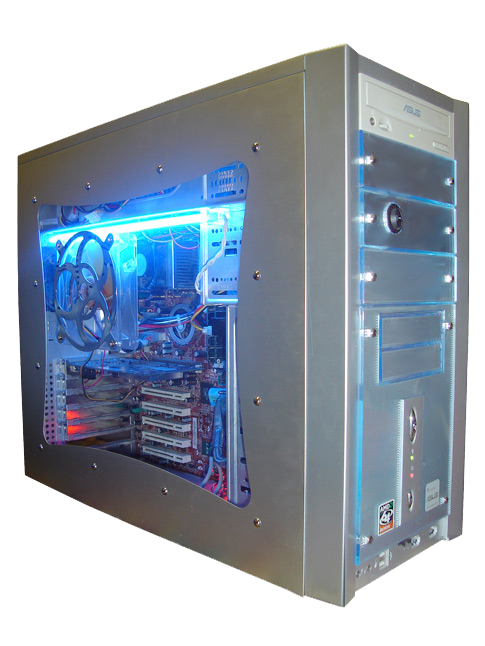This first post covers the four main categories of PC hardware components and how they link together to complete a computer system. Every computer system is made up of the first three categories below, with practically every system containing at least one item in the last category (Peripheral Devices).
It's unlikely that you've never seen at least one representation of the below devices, the fact that you're reading this means that you must be utilising the majority right now! That said, you may not be aware of how the system is broken down into it's various categories and this may help clarify how these work.
The System Unit, also known as the CPU or the 'Tower', is the the main component of a computer which houses most of the components required for the PC to operate. Disk drives, boards, adapters, power supply, ports etc are all mounted inside this main component.
Other Terms: Box, Main Unit, Base Unit, Tower, Computer Chassis, Case, Computer Case
Note: In newer PC's, the System Unit may be housed within the monitor itself (known as an all-in-one computer). This is similar to the way laptops are configured, but can make the carrying out of maintenance more difficult to carry out.
Display Devices are personal computer components that enable the user to view the informational output (such as text and graphical data) from computers. Display devices are mostly connected to the system unit via a cable and always have controls to adjust settings.
Other Terms: Monitor, Screen, LCD (Liquid Crystal Display), Flat Panel
Input Devices are PC components that allow the user to enter information and data into the computer. Input devices most commonly seen are keyboards and computer mice, although with the invention of touch screen the way information can be entered is becoming more diverse. Input devices can be connected to a PC via cables or a wireless connection.
Peripheral Devices can enhance the functionality of almost every personal computer by adding additional input, output and data storage capabilities. Peripheral devices can be connected to the System Unit by cable or wireless connection and many current devices have the facility to be connected by either.
Some peripheral devices have their own power source, while others draw their power from the System Unit.
Example Devices: Speakers, Printers, Scanners, Microphones, External Disc Drives, Cameras
Note: Of the above devices, Speakers and Printers are Output Devices. Microphones & Cameras are Input Devices and External Disc Drives are Input/Output Devices.
Study Reference Disclaimer.
It's unlikely that you've never seen at least one representation of the below devices, the fact that you're reading this means that you must be utilising the majority right now! That said, you may not be aware of how the system is broken down into it's various categories and this may help clarify how these work.
The System Unit, also known as the CPU or the 'Tower', is the the main component of a computer which houses most of the components required for the PC to operate. Disk drives, boards, adapters, power supply, ports etc are all mounted inside this main component.
Other Terms: Box, Main Unit, Base Unit, Tower, Computer Chassis, Case, Computer Case
 |
| A 'System Unit' |
Note: In newer PC's, the System Unit may be housed within the monitor itself (known as an all-in-one computer). This is similar to the way laptops are configured, but can make the carrying out of maintenance more difficult to carry out.
Display Devices are personal computer components that enable the user to view the informational output (such as text and graphical data) from computers. Display devices are mostly connected to the system unit via a cable and always have controls to adjust settings.
Other Terms: Monitor, Screen, LCD (Liquid Crystal Display), Flat Panel
 |
| A Liquid Crystal Display (LCD) Monitor |
Input Devices are PC components that allow the user to enter information and data into the computer. Input devices most commonly seen are keyboards and computer mice, although with the invention of touch screen the way information can be entered is becoming more diverse. Input devices can be connected to a PC via cables or a wireless connection.
 |
| A Cabled Computer Mouse (Input Device) |
Peripheral Devices can enhance the functionality of almost every personal computer by adding additional input, output and data storage capabilities. Peripheral devices can be connected to the System Unit by cable or wireless connection and many current devices have the facility to be connected by either.
Some peripheral devices have their own power source, while others draw their power from the System Unit.
Example Devices: Speakers, Printers, Scanners, Microphones, External Disc Drives, Cameras
 |
| Example Process of Peripheal Devices |
Note: Of the above devices, Speakers and Printers are Output Devices. Microphones & Cameras are Input Devices and External Disc Drives are Input/Output Devices.
Study Reference Disclaimer.
Comments
Post a Comment